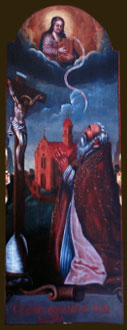 The next scene of the cycle does not yet reveal the Saint herself, though it happens after her birth. In the foreground we can see a bishop, an elderly man kneeling in deep prayer. This is Benedict, a parish priest of Rasbo, who on 14 June was praying that Ingeborga would happily give birth to her baby. In heavens where he is directing his gaze, he sees Mary with a book in her hand speaking to him: NATA EST BIRGERO FILIA, CUIUS VOX ADMIRABILIS AUDIETUR PER ORBEM ('A daughter was born to Birger, her voice will be heard in the whole world').
The next scene of the cycle does not yet reveal the Saint herself, though it happens after her birth. In the foreground we can see a bishop, an elderly man kneeling in deep prayer. This is Benedict, a parish priest of Rasbo, who on 14 June was praying that Ingeborga would happily give birth to her baby. In heavens where he is directing his gaze, he sees Mary with a book in her hand speaking to him: NATA EST BIRGERO FILIA, CUIUS VOX ADMIRABILIS AUDIETUR PER ORBEM ('A daughter was born to Birger, her voice will be heard in the whole world').
The painting is also signed with the words: CAELITUS ANUNTIATUR NATAE GLORIA (The glory of the born is announced from heaven). When Bridget was to be born the guardian of the nearby church, who in the future became the Aibona bishop, had a wonderful vision. Praying at the time of her birth, a cloud appeared to him, and in the cloud he saw Mary holding a book in her hand. Then she told him that a daughter was just born to Birger and she would preach the joy of salvation.
This scene is set against the landscape with a clearly marked silhouette of the church. This church has a very characteristic stepped finished top of the facade with pinnacles sticking out beyond the plain. The top is decorated with three rows of blends separated from each other by stretches of ledges. The facade has an entrance portal, above which there is a tracery window. The iconographic comparisons show that this is a church of the Bridgettines in Lublin before going up a tower to the church's building body.






